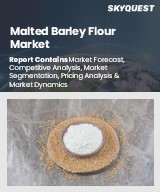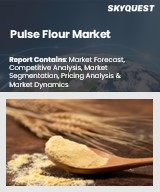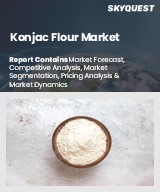
|
시장보고서
상품코드
1806099
맥아 보리가루 시장 규모, 점유율, 성장 분석 : 제품별, 유래별, 최종 용도별, 지역별 산업 예측(2025-2032년)Malted Barley Flour Market Size, Share, and Growth Analysis, By Product (Diastatic, Non-Diastatic), By Source (Organic, Conventional), By End Use, By Region - Industry Forecast 2025-2032 |
||||||
세계의 맥아 보리가루 시장 규모는 2023년 27억 달러로 평가되었으며, 2024년 28억 6,000만 달러에서 2032년에는 46억 달러에 이를 것으로 예측되며 예측 기간(2025-2032년)의 CAGR은 6.1%를 나타낼 전망입니다.
세계의 맥아 보리가루 시장은 소비자의 건강 의식 고조와 곡물 기반 식품의 이점에 힘입어 견실한 성장을 경험하고 있습니다. 보리의 높은 섬유질 함량과 낮은 콜레스테롤 수치에 대한 인식이 높아지면서 수요가 촉진되고 있으며, 보리의 효소가 건강을 중시하는 소비자들의 식품 선호도를 높이고 있습니다. 이 가루는 탁월한 풍미와 기능성 특성으로 인해 제빵 및 제과 분야에서 점점 더 선호되고 있으며, 합성 첨가물 없이 자연적인 대안을 제공합니다. 또한 수제 맥주 산업의 디아스타틱 맥아 보리가루 수요가 시장 중요성을 높이고 있습니다. 건강 프로필을 갖춘 간편식·즉석식품으로의 전환과 유기농·글루텐 프리 제품 시장 확대 역시 사용량을 증가시키고 있습니다. 제분 및 가공 기술 발전은 산업 효율성을 높이는 동시에 일관된 제품 품질을 보장합니다.
목차
소개
- 조사의 목적
- 조사 범위
- 정의
조사 방법
- 정보 조달
- 2차와 1차 데이터 방법
- 시장 규모 예측
- 시장의 전제조건과 제한
주요 요약
- 세계 시장 전망
- 공급과 수요 동향 분석
- 부문별 기회 분석
시장 역학과 전망
- 시장 개요
- 시장 규모
- 시장 역학
- 성장 촉진요인과 기회
- 성장 억제요인과 과제
- Porter's Five Forces 분석
주요 시장 인사이트
- 중요 성공요인
- 경쟁도
- 주요 투자 기회
- 시장 생태계
- 시장 매력 지수(2024년)
- PESTEL 분석
- 거시 경제 지표
- 밸류체인 분석
- 가격 분석
- 사례 연구
- 구매 고객 행동 분석
보리맥아가루 시장 규모 : 제품별, CAGR(2025년-2032년)
- 시장 개요
- 디아스타틱
- 비디아스타틱
보리맥아분 시장 규모 : 유래별, CAGR(2025년-2032년)
- 시장 개요
- 유기농
- 기존
보리맥아분 시장 규모 : 최종 용도별, CAGR(2025년-2032년)
- 시장 개요
- 베이커리
- 영양 및 스낵 식품
- 과자류
- 향료
- 가정용
- 기타
보리맥아가루 시장 규모 : 지역별, CAGR(2025년-2032년)
- 북미
- 미국
- 캐나다
- 유럽
- 독일
- 스페인
- 프랑스
- 영국
- 이탈리아
- 기타 유럽
- 아시아태평양
- 중국
- 인도
- 일본
- 한국
- 기타 아시아태평양
- 라틴아메리카
- 브라질
- 기타 라틴아메리카
- 중동 및 아프리카
- GCC 국가
- 남아프리카
- 기타 중동 및 아프리카
경쟁 정보
- 상위 5개사 비교
- 주요 기업 시장 포지셔닝(2024년)
- 주요 시장 기업의 채택 전략
- 최근 시장 동향
- 기업 시장 점유율 분석(2024년)
- 주요 기업 프로파일
- 기업의 상세
- 제품 포트폴리오 분석
- 기업의 부문별 점유율 분석
- 전년대비 수익 비교(2022-2024년)
주요 기업 프로파일
- Malteurop Group
- Cargill Inc.
- GrainCorp
- Soufflet Group
- Crisp Malting Group
- IREKS GmbH
- Global Malt GmbH & Co. KG
- Muntons Plc
- Ardent Mills
- Richardson Malting(UK) Limited
- Boortmalt
- Briess Malt Ingredients
- Mirfak Pty Ltd.
- Vertical Malt
결론 및 권고사항
HBR 25.09.16Global Malted Barley Flour Market size was valued at USD 2.7 billion in 2023 and is poised to grow from USD 2.86 billion in 2024 to USD 4.6 billion by 2032, growing at a CAGR of 6.1% during the forecast period (2025-2032).
The global malted barley flour market is experiencing robust growth driven by rising consumer health consciousness and the benefits of grain-based foods. Increased awareness of barley's high fiber content and low cholesterol levels is fueling demand, as its enzymes enhance food appeal for health-focused consumers. The flour is increasingly sought after in the bakery and confectionery sectors for its exceptional flavor and functional properties, offering natural alternatives without synthetic additives. Furthermore, the craft brewing industry's demand for diastatic malted barley flour supports its growing importance. The shift towards convenient, ready-to-eat foods with healthy profiles also boosts its usage, along with an expanding market for organic and gluten-free products. Advances in milling and processing technology ensure consistent product quality while enhancing industrial efficiency.
Top-down and bottom-up approaches were used to estimate and validate the size of the Global Malted Barley Flour market and to estimate the size of various other dependent submarkets. The research methodology used to estimate the market size includes the following details: The key players in the market were identified through secondary research, and their market shares in the respective regions were determined through primary and secondary research. This entire procedure includes the study of the annual and financial reports of the top market players and extensive interviews for key insights from industry leaders such as CEOs, VPs, directors, and marketing executives. All percentage shares split, and breakdowns were determined using secondary sources and verified through Primary sources. All possible parameters that affect the markets covered in this research study have been accounted for, viewed in extensive detail, verified through primary research, and analyzed to get the final quantitative and qualitative data.
Global Malted Barley Flour Market Segments Analysis
Global Malted Barley Flour Market is segmented by Product, Source, End Use and region. Based on Product, the market is segmented into Diastatic and Non-Diastatic. Based on Source, the market is segmented into Organic and Conventional. Based on End Use, the market is segmented into Bakeries, Nutritional & Snack Foods, Confectioneries, Flavourings, Households and Others. Based on region, the market is segmented into North America, Europe, Asia Pacific, Latin America and Middle East & Africa.
Driver of the Global Malted Barley Flour Market
The rising awareness of health benefits associated with malted barley flour has significantly fueled its market demand, particularly among health-conscious individuals seeking gluten-free, organic, and whole grain options. Its high fiber content and cholesterol-free qualities contribute to its appeal, especially given the growing emphasis on digestive health. This heightened health consciousness has led to an increased incorporation of malted barley flour in various sectors, including confectionery, bakery, and functional foods, as consumers prioritize nutritious ingredients in their diets. As a result, this trend is driving a surge in the global acceptance and usage of malted barley flour.
Restraints in the Global Malted Barley Flour Market
The Global Malted Barley Flour market faces significant challenges due to the presence of alternative flours such as wheat, oat, and rye, which serve as potential substitutes. These alternatives often provide comparable functional and nutritional advantages, leading consumers to choose them based on factors like cost or specific recipe requirements. This abundance of substitute products in the marketplace poses a limitation on the growth potential of malted barley flour, as buyers may prioritize more readily available and economical options that meet their needs. Consequently, the competitive landscape diminishes the likelihood of malted barley flour gaining substantial market traction.
Market Trends of the Global Malted Barley Flour Market
The Global Malted Barley Flour market is experiencing a significant shift driven by an increasing consumer preference for organic and clean label products. As health-conscious consumers seek natural, minimally processed ingredients, the demand for organic malted barley flour is surging. Producers are responding by offering fortified and specialty flour options that cater to diverse dietary needs, including gluten-free and high-fiber alternatives. This trend not only reflects the growing awareness of health and nutrition but also emphasizes sustainability, as consumers increasingly prioritize products that are ethically sourced and environmentally friendly, enhancing the overall value proposition of malted barley flour in the global market.
Table of Contents
Introduction
- Objectives of the Study
- Scope of the Report
- Definitions
Research Methodology
- Information Procurement
- Secondary & Primary Data Methods
- Market Size Estimation
- Market Assumptions & Limitations
Executive Summary
- Global Market Outlook
- Supply & Demand Trend Analysis
- Segmental Opportunity Analysis
Market Dynamics & Outlook
- Market Overview
- Market Size
- Market Dynamics
- Drivers & Opportunities
- Restraints & Challenges
- Porters Analysis
- Competitive rivalry
- Threat of substitute
- Bargaining power of buyers
- Threat of new entrants
- Bargaining power of suppliers
Key Market Insights
- Key Success Factors
- Degree of Competition
- Top Investment Pockets
- Market Ecosystem
- Market Attractiveness Index, 2024
- PESTEL Analysis
- Macro-Economic Indicators
- Value Chain Analysis
- Pricing Analysis
- Case Studies
- Customer Buying Behavior Analysis
Global Malted Barley Flour Market Size by Product & CAGR (2025-2032)
- Market Overview
- Diastatic
- Non-Diastatic
Global Malted Barley Flour Market Size by Source & CAGR (2025-2032)
- Market Overview
- Organic
- Conventional
Global Malted Barley Flour Market Size by End Use & CAGR (2025-2032)
- Market Overview
- Bakeries
- Nutritional & Snack Foods
- Confectioneries
- Flavourings
- Households
- Others
Global Malted Barley Flour Market Size & CAGR (2025-2032)
- North America (Product, Source, End Use)
- US
- Canada
- Europe (Product, Source, End Use)
- Germany
- Spain
- France
- UK
- Italy
- Rest of Europe
- Asia Pacific (Product, Source, End Use)
- China
- India
- Japan
- South Korea
- Rest of Asia-Pacific
- Latin America (Product, Source, End Use)
- Brazil
- Rest of Latin America
- Middle East & Africa (Product, Source, End Use)
- GCC Countries
- South Africa
- Rest of Middle East & Africa
Competitive Intelligence
- Top 5 Player Comparison
- Market Positioning of Key Players, 2024
- Strategies Adopted by Key Market Players
- Recent Developments in the Market
- Company Market Share Analysis, 2024
- Company Profiles of All Key Players
- Company Details
- Product Portfolio Analysis
- Company's Segmental Share Analysis
- Revenue Y-O-Y Comparison (2022-2024)
Key Company Profiles
- Malteurop Group
- Company Overview
- Business Segment Overview
- Financial Updates
- Key Developments
- Cargill Inc.
- Company Overview
- Business Segment Overview
- Financial Updates
- Key Developments
- GrainCorp
- Company Overview
- Business Segment Overview
- Financial Updates
- Key Developments
- Soufflet Group
- Company Overview
- Business Segment Overview
- Financial Updates
- Key Developments
- Crisp Malting Group
- Company Overview
- Business Segment Overview
- Financial Updates
- Key Developments
- IREKS GmbH
- Company Overview
- Business Segment Overview
- Financial Updates
- Key Developments
- Global Malt GmbH & Co. KG
- Company Overview
- Business Segment Overview
- Financial Updates
- Key Developments
- Muntons Plc
- Company Overview
- Business Segment Overview
- Financial Updates
- Key Developments
- Ardent Mills
- Company Overview
- Business Segment Overview
- Financial Updates
- Key Developments
- Richardson Malting (UK) Limited
- Company Overview
- Business Segment Overview
- Financial Updates
- Key Developments
- Boortmalt
- Company Overview
- Business Segment Overview
- Financial Updates
- Key Developments
- Briess Malt Ingredients
- Company Overview
- Business Segment Overview
- Financial Updates
- Key Developments
- Mirfak Pty Ltd.
- Company Overview
- Business Segment Overview
- Financial Updates
- Key Developments
- Vertical Malt
- Company Overview
- Business Segment Overview
- Financial Updates
- Key Developments



















